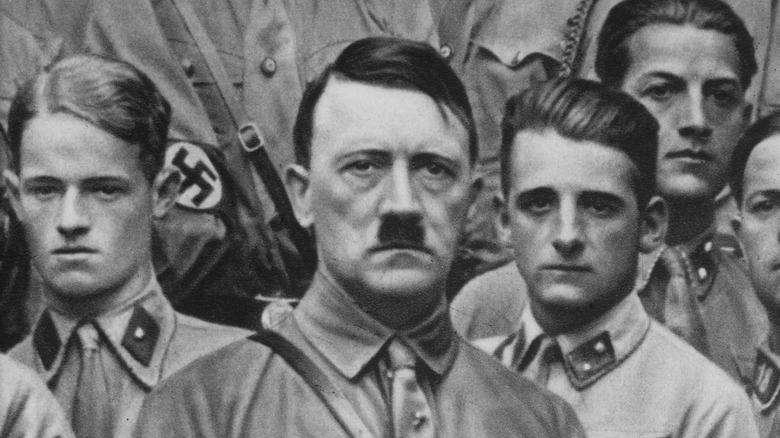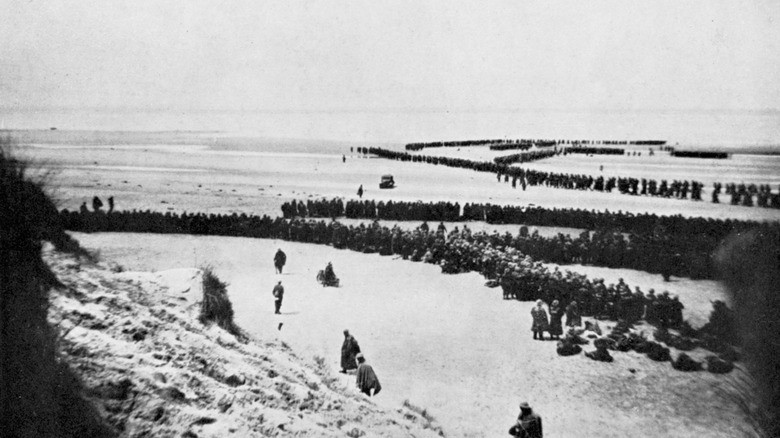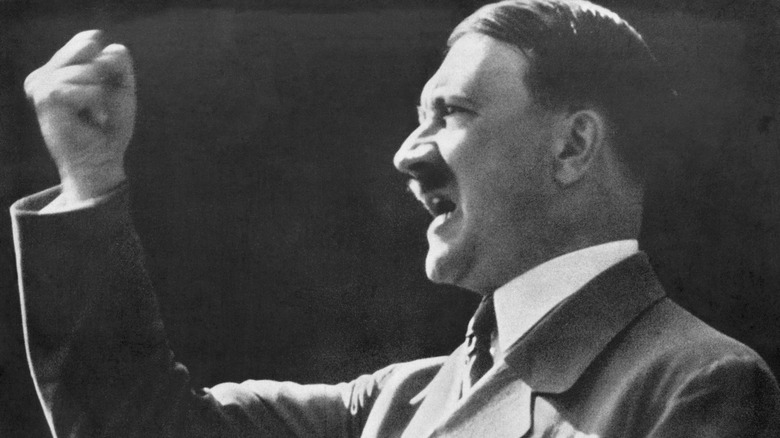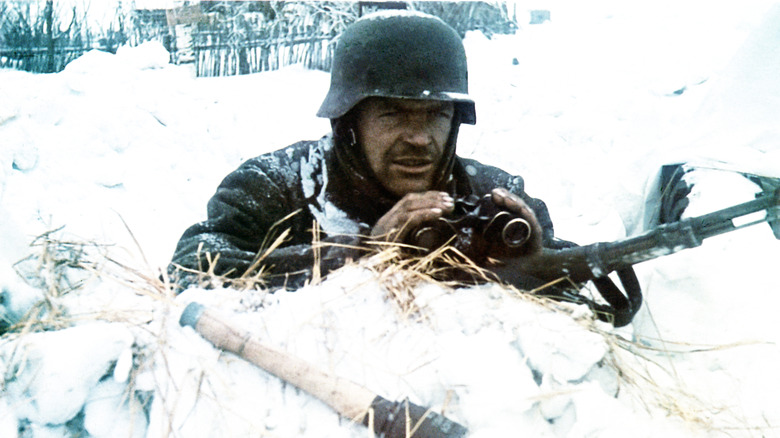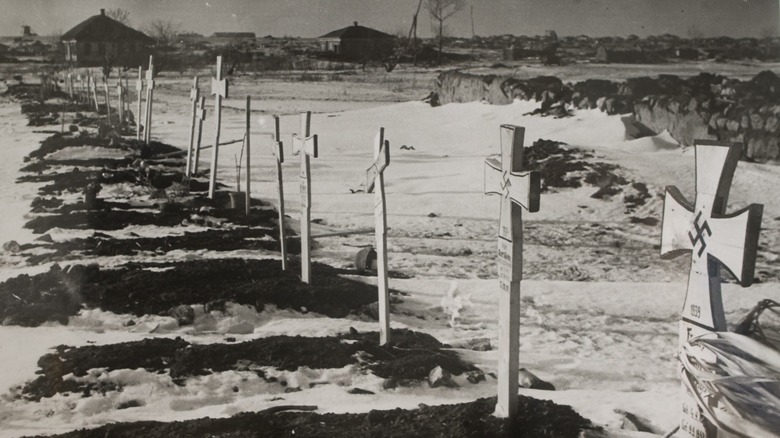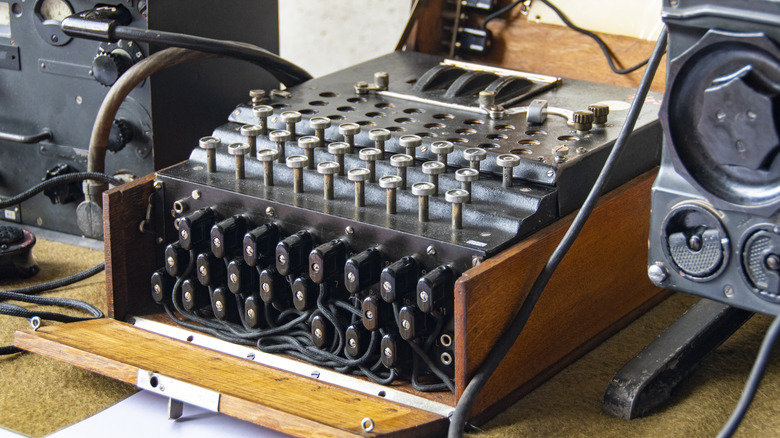The Biggest Mistakes That Cost Hitler World War II
The rise of Adolf Hitler in postwar Germany was no sudden occurrence. He first formed the National Socialist German Workers' Party (or Nazi Party) in 1920, and it remained a tiny, fringe political element for years. In 1923, he attempted to gain power via the Beer Hall Putsch, for which he was convicted of treason and incarcerated the following year. In prison, he wrote his notorious memoir, "Mein Kampf," and refined his fascistic world view. By the 1930s, the public was turning toward his way of seeing things, and after being voted into office, Hitler consolidated his power with the Enabling Act, which made him the de facto leader of Nazi Germany in perpetuity.
Around this time, the Nazis orchestrated a rejection of modern art and culture in favor of classically-inspired fascistic imagery and stated that their aim was to see their German State — the Third Reich — rule for 1,000 years. With glory in mind, they developed expansionist policies that saw them declare war on neighboring European states, beginning with Poland on September 1, 1939. Indeed, Hitler's government looked likely to overrun the continent with their immense military strength.
However, by the end of April 1945, Nazi Germany was utterly destroyed, with Hitler dead in his bunker as Soviet forces closed in on Berlin. It was a dramatic fall for the would-be empire, but defeat was not exactly a given when World War II began in 1939. Historians now understand that Hitler and the Nazis made several key blunders in terms of military strategy, which helped prevent Europe from falling under their complete control.
A halt order allowed the Dunkirk Miracle to take place
Two days after Nazi Germany invaded Poland, allies Britain and France, who had made a pact to protect Polish borders, declared war against the aggressors. Their military intervention was initially slow, so much so that the period after the pronouncement has come to be known as the "Phoney War." Eventually, the British Expeditionary Force arrived in France, joining French troops that soon found themselves attempting to resist German maneuvers in their own territory. The German military employed blitzkrieg tactics, which involved the coordinated use of heavy artillery such as Panzer tanks alongside aerial bombardment and missile strikes. They soon pushed the Allied troops all the way back to the west coast of France, where they looked likely to be wiped out by the advancing Nazis.
However, despite their evident military superiority at the time, the Nazi forces decided to hold off on chasing down their exhausted enemy, with high command issuing a 36-hour pause on their Panzer divisions' advancement. Hitler reportedly believed that allowing the British to escape to the U.K. would show the world they had been dominated and cause a huge psychological blow. However, the escape of nearly 340,000 British and French troops in the evacuation known as Operation Dynamo was framed as a victory in the U.K. and saw the Allies ready to regroup as the war escalated.
The audacious evacuation was ultimately so successful that it became known as the Dunkirk Miracle. It remains one of the most famous and celebrated Allied actions of World War II (Christopher Nolan directed an award-winning movie about the event that was released in 2017). But the truth is that a Nazi tactical blunder allowed it to happen.
Declaring war on the United States
The early stages of World War II saw British and French forces come close to being obliterated and letting France and Poland fall under Nazi control. During this period, the United States supported the countries that would later become their allies in war with military supplies and equipment. Across the Atlantic Ocean, the battles raging in Europe appeared remote to the American people. Their attention was focused primarily on Japan, which by then had invaded China and looked likely to attack the U.S. On December 7, 1941, that offensive finally came, with Japan subverting America's underestimation of their military power and carrying out a surprise strike on Pearl Harbor.
The assault enraged the American people, and the U.S. declared war on Japan the next day, potentially reducing its sharing of resources with its European allies as a result. Three days later, Adolf Hitler declared war on the United States. It is a decision that remains a point of much discussion among historians. According to "Hitler's American Gamble" authors Brendan Simms and Charlie Laderman, it was "Hitler's greatest strategic error."
Following the declaration, President Franklin D. Roosevelt was able to face down American anger at the Japanese and order a full-blown resistance against Nazi Germany. The declaration led to the D-Day landings in 1944. Hitler's decision brought a powerful enemy to his doorstep needlessly and turned the tide against his forces as American troops spearheaded the fightback. It was the beginning of the end for the Third Reich.
Opening a second front
Adolf Hitler's reportedly gleeful declaration of war against the United States wasn't the only time he unnecessarily provoked a giant during World War II. In 1939, Germany and the Soviet Union signed a nonaggression pact. Despite being enemies, they agreed to carve up Eastern Europe between them without attacking one another. In the aftermath, the Soviets attacked Eastern Poland. But on June 22, 1941, Hitler launched Operation Barbarossa, a surprise strike against the Soviet Union involving around 3 million troops.
The size of the operation was justifiable: The Soviet Union represented the most expansive country on earth, with the world's largest standing army. However, Hitler was certain that the vast nation was a paper tiger. In his eyes, the Soviets' difficulties invading Finland the previous year exposed their lack of military command and equipment.
But the eastern landscape was vast, and the Nazi forces found themselves struggling with the region's cold weather and the fierce resistance of the Soviet troops. Extending their supply lines across their territory and now fighting a war on two fronts, Operation Barbarossa ultimately proved to be a disaster for the Third Reich. And another was to follow.
Trying to take Stalingrad
As the Nazi forces turned their attention toward the Soviet Union, Adolf Hitler instructed his generals to push toward what he believed were the sprawling county's most important strategic territories and assets. Rather than march on Moscow — a move that experts say could possibly have signaled defeat for Joseph Stalin — the Germans turned their attention toward the oil fields to the south, seeing the city of Stalingrad as a strategic linchpin.
The Battle of Stalingrad was the decisive confrontation of the Eastern Front. Hundreds of thousands of troops poured into the city from both sides for what turned out to be one of the bloodiest battles in military history. Neither Hitler or Stalin were willing to back down, and amid the fighting, soldiers were decimated by starvation, exposure, and an increasing lack of supplies.
Whereas the Nazi forces had previously used their blitzkrieg tactics to great effect in expanding through Europe, after turning much of Stalingrad to rubble, they found they were unable to maneuver their tank divisions through the city. They had to resort to brutal urban warfare that often descended into hand-to-hand combat. Hundreds of thousands of soldiers were killed, with the Soviets eventually winning the upper hand and holding the city despite unimaginable casualties. It was one of the turning points of World War II, with Russian forces eventually regrouping to reclaim their territory before marching on Berlin for what would prove to be the defeat of Nazi Germany.
Allowing British intelligence to get the upper hand
World War II wasn't fought with brute force alone. Both sides poured a huge amount of resources into developing new technologies that would change the face of the conflict by protecting military intelligence and undermining that of the enemy. For the Nazis, this took the form of the Enigma machine, a device resembling a typewriter that allowed them to transmit encoded messages with sensitive information that the Allied forces couldn't understand if they intercepted them.
During the expansion of the Third Reich, the technology became an indispensable asset in Adolf Hitler's military. However, understanding the danger of the Enigma machine, the British government assembled a team of mathematicians to crack the code shortly after declaring war on Germany. Hitler and his generals assumed that the device was untouchable, with each message having potentially billions of possible encryptions.
But they were blind to the technology's weaknesses. Consistencies in Nazi messages — including the regularity of weather reports, the use of repeated phrases such as "Heil Hitler," along with other insights — were its downfall. These patterns allowed the British team led by mathematician Alan Turing, who was later understood to be a vital war hero, to break the Enigma. The breakthrough gave the Allied forces vital intelligence during some of World War II's most decisive battles, including the Battle of the Atlantic, and ultimately contributed to the destruction of the Third Reich.
